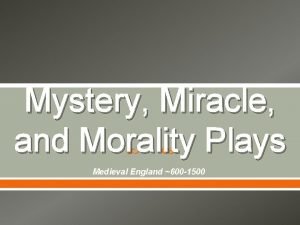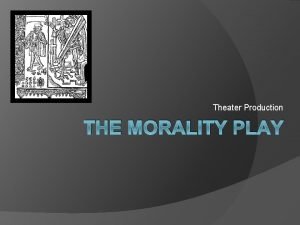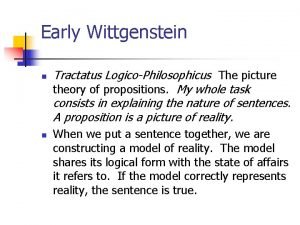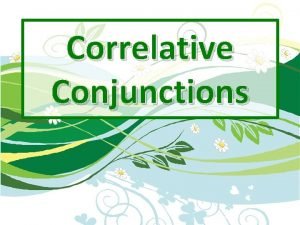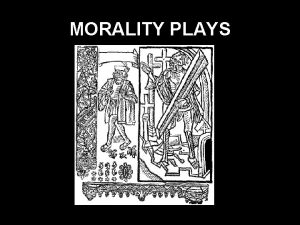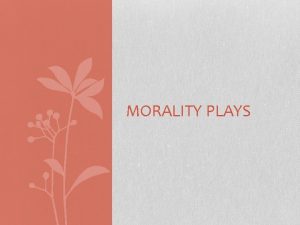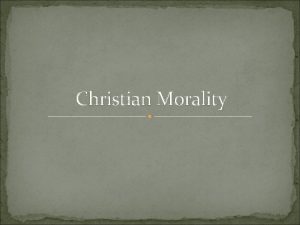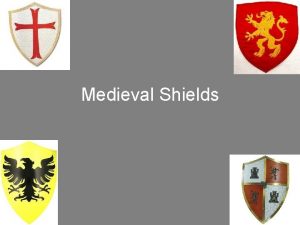MORALITY PLAYS Morality Plays Only five medieval English













- Slides: 13


MORALITY PLAYS

Morality Plays Only five medieval English morality plays still survive: 1. The Pride of Life (a corrupted Anglo-Irish text) 2. The Castle of Perseverance 3. Wisdom 4. Mankind 5. Everyman (translated from a Dutch original. ) Two other plays similar to Morality Plays still exist: 1. Second Sheppard's Play 2. Hickscorner These are all that are left of an influential dramatic genre. The understanding of style has been developed based upon the influence these plays had on surviving literature and art

Morality Plays • An attempt to educate via entertainment • Dominican and Franciscan monks developed the morality play in the 13 th century by adding actors and theatrical elements to their sermons. • They hoped the (mainly illiterate) masses could more easily learn the basics of Christianity through dramatic spoken word. • The plays made complex topics such as original sin and atonement more easily understood. • By personifying Vices, Virtues, the Devil and the Good Angel, stories of temptation were made accessible to those who were unable to read.

Morality Plays • The main theme of the morality play is this: 1. Man begins in innocence 2. Man falls into temptation 3. Man repents and is saved. • The central action is the struggle of Man against the seven deadly sins that are personified into real characters • It is believed that the allegory of vices and virtues fighting over Man’s soul goes back to the 4 th century Roman epic, • The allegorical application of theatre to Christianity is intended to help the audience understand sin and virtue

Morality Plays • The three greatest temptations that Man faces in morality plays are 1. The World 2. The Flesh 3. The Devil THE MESSAGE: “Sin is inevitable” “Repentance is always possible” • Morality plays were not holiday-specific • Performed at any time of the year. Repentance occurs at any time of the year.

Morality Plays Characteristics 1. A protagonist who represents either humanity as a whole or a smaller social structure. 2. Supporting characters are personifications of good and evil. 3. Provides the audience with moral guidance. 4. Morality plays encourage men to live a righteous life

Everyman The archetypal morality play Characters represent broad ideas Characters in Everyman are: 1. God 2. Death 3. Everyman 4. Goods (Riches) 5. Good-Deeds 6. Angel 7. Knowledge 8. Beauty 9. Discretion 10. Strength 11. Doctor The personified meanings of these characters are not hidden

Everyman PLOT: God, believing that the people on earth are too focused on wealth and worldly possessions, sends Death to Everyman to remind him of God's power and the importance of upholding values. EVERYMAN is a concrete example of a Morality Play because of… 1. The emphasis put on morality 2. The vast difference between good and evil 3. The strong presence of God However, most morality plays focus more on evil, while Everyman focuses more on good, highlighting sin in contrast.

The Castle of Perseverance Written around 1425 The manuscript includes stage directions, together with a staging plan. • South is at the top of the diagram. • The two concentric circles border the main playing area. • In the center of this area is a castle raised on legs, with a bed below it.

The Castle of Perseverance Staging Directions from the manuscript

The Castle of Perseverance • The playing area was constructed as a "ditch-and-hill" theater. The surrounding ring was filled with water. • This obstructed non-paying spectators. • The paying audience was seated on a hill built just within the ring. Spectators could also sit or stand near the center and move freely around the playing area. Southern estimates that t • The theater was about 126 feet across and could accommodate an audience of a thousand or more. • In addition to the center stage, scaffolds were situated around the ring to provide separate acting areas. • These would have been connected to the center by walkways through the crowd. • The play was probably performed by travelling professionals who would have to construct such a stage at every town on their tour. (The Medieval Theatre in the Round (London: Faber and Faber Limited, 1957)

Hickscorner Characters Contemplation, Perseverance, Imagination, and Free Will. Reproduced in H. W. Mabie, William Shakespeare (1900).
 Mystery plays and morality plays
Mystery plays and morality plays Morality play characteristics
Morality play characteristics Morality plays characteristics
Morality plays characteristics Slave morality
Slave morality Where was friedrich nietzsche born
Where was friedrich nietzsche born Slave vs master morality
Slave vs master morality These are words that are called joiners or connectors
These are words that are called joiners or connectors British literature notes
British literature notes Characteristics of medieval english literature
Characteristics of medieval english literature Medieval english music
Medieval english music Medieval times translator
Medieval times translator Characteristics of medieval period in english literature
Characteristics of medieval period in english literature Leave only footprints take only photos
Leave only footprints take only photos And now with gleams of half-extinguished thought
And now with gleams of half-extinguished thought
